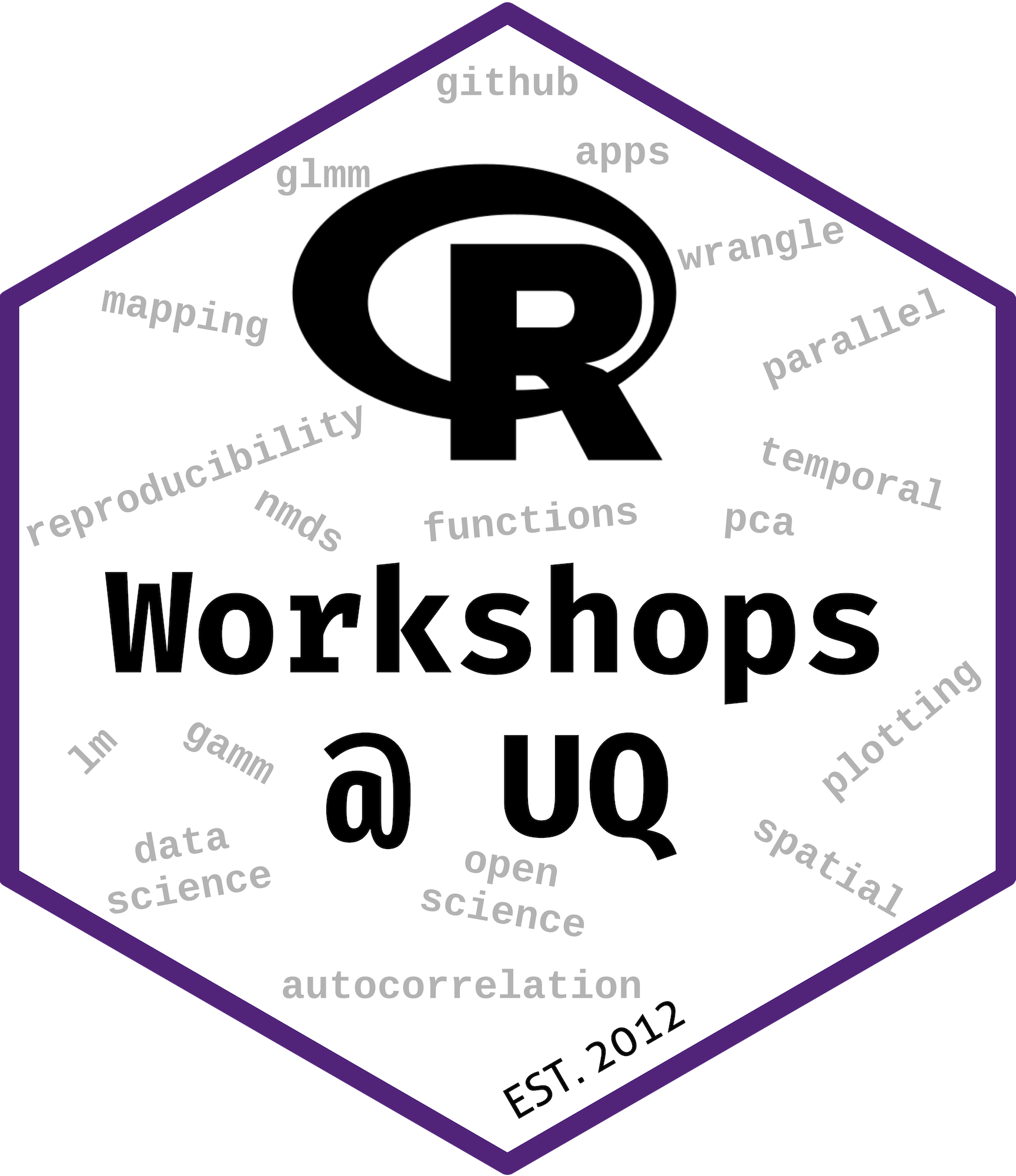2026 Winter R Workshops @ UQ
Building your Data Science Skills in R
Are you ready to take your R skills to the next level and conquer the challenges of messy data? Transform raw data into actionable insights with our July Workshops in an immersive journey into the art and science of data wrangling in R.
These intensive, hands-on workshops are designed for individuals with a foundational understanding of R who are eager to master the essential skills for effective data wrangling, code organisation, advanced visualisation, spatial analysis, and building interactive Shiny apps. Join us to elevate your R proficiency and become a data manipulation and presentation expert!
This workshop series will run in July 2026 at the University of Queensland. You are free to attend as many or as few days as you would like.
All proceeds from these workshops are used to support research at UQ and UniSC.
Day 1 (July 2026) Data Wrangling 1
We’ll kick off by mastering the tidyverse, R’s powerful and intuitive ecosystem of packages designed for data manipulation. Learn to read and write data seamlessly with readr. Handle messy data structures with tidyr and tidyselect. Learn to effortlessly clean, transform and filter your data using dplyr with joins, renaming, grouping and summarising. Get hands-on experience with pipes, data frames, and the core verbs that will become your go-to for efficient data preparation.
Day 2 (July 2026) Data Wrangling 2
Unleashing the elegance of functional programming. Discover the power and conciseness of functional programming in R. Learn to write cleaner, more modular, and reusable code by embracing functions. Explore concepts like mapping, filtering, and reducing with the purrr package, enabling you to apply operations across your data in a streamlined and expressive way. We will use furrr to demonstrate how to leverage the functionality of purrr for parallel processing, allowing you to speed up your analyses. We’ll also lay the foundations for writing your own R packages, understanding the motivations and basic structure involved in creating shareable and reproducible code (with help from the devtools metapackage).
Day 3 (July 2026) Visual Storytelling
Go beyond the basics and unlock the full potential of advanced ggplot2 in order to create publication-ready graphics. Learn to create sophisticated and informative visualisations by mastering layers, scales, legends, themes, annotations, faceting, statistical geoms, and writing functions with ggplot2 to automate your graphics. Discover advanced techniques for customising your plots to communicate complex data effectively. Combine plots using patchwork, and animate your plots and render them within quarto web documents.
Day 4 (July 2026) Mapping our World
Today we will delve into the exciting and increasingly crucial world of spatial mapping and analysis. We will teach you to work with various spatial data formats, create informative maps, perform fundamental spatial operations, visualize geographical patterns and gain insights from location-based information. We’ll explore the sf package for working with vector data (points, lines, polygons) in a tidy and intuitive way, mastering how to read, manipulate, and visualize geographic features. We’ll demonstrate the terra package for handling raster data (gridded data like satellite imagery or environmental layers), covering essential raster manipulation and analysis techniques. Finally, we’ll touch upon the stars package for working with spatiotemporal array data, providing a glimpse into handling more complex, multi-dimensional spatial datasets. By the end of the day, you’ll be able to confidently bring your spatial data to life and extract meaningful insights from its geographic context.
Day 5 (July 2026) Building Interactive Web Apps with Shiny
Discover how to bring your meticulously wrangled and analysed data into engaging and accessible interactive web applications with our introduction to Shiny. Learn the fundamental structure of Shiny apps and how to build user-friendly interfaces with interactive controls like sliders and dropdown menus and radio buttons. Discover the power of reactivity to create dynamic outputs, allowing users to explore your ggplot2 visualizations and DT data tables in real-time within a web browser. By the end of the day, you’ll gain the foundational skills to build simple yet powerful interactive tools, making your R analyses accessible to a wider audience.
